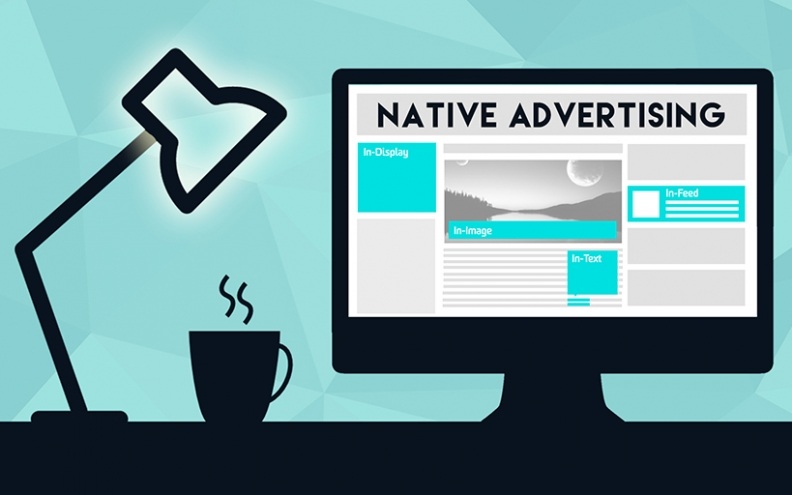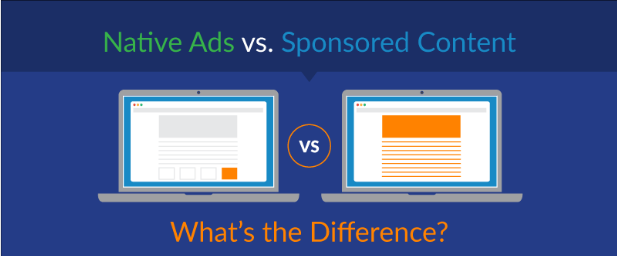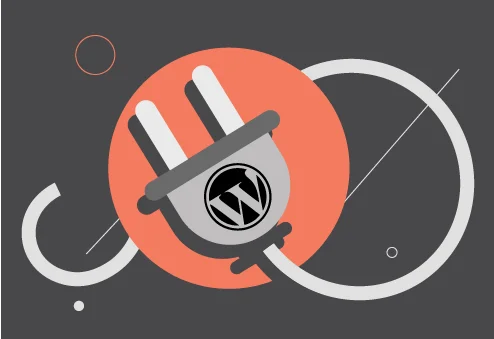In today’s digital world, brands have many options when it comes to promoting themselves and connecting with customers online.
Two of the most popular digital marketing tactics are native advertising and content marketing. Both can be highly effective at driving engagement and conversions when executed correctly.
But what exactly is the difference between native advertising and content marketing? While the two strategies share some similarities and can complement one another, they have some distinct differences that brands should understand.

Both strategies aim to capture audience attention and drive action. But native advertising does so through paid media placements while content marketing relies on organic reach through owned channels.
In this post, we’ll dive deeper into how native advertising and content marketing compare so you can determine the best digital marketing investment for your brand objectives and budget.
Definition Of Native Advertising

Native advertising can be defined as a form of online advertising that matches the form and function of the platform on which it appears. Unlike traditional banner ads or display ads, native advertisements are designed to blend in with the surrounding content, making them less intrusive and more appealing to the audience.
This ad format aims to provide value to the user by delivering relevant and engaging content that aligns with the platform’s overall user experience.
Benefits Of Native Advertising
Native advertising offers several benefits that make it a valuable tool in the digital marketing landscape:
- Improved user experience: By integrating seamlessly with the platform’s content, native ads provide a non-disruptive experience to users, enhancing their overall satisfaction and engagement.
- Increased reach and visibility: Native ads have the potential to reach a wider audience, as they are usually displayed within highly frequented platforms. This increased visibility helps to drive brand awareness and exposure.
- Enhanced credibility and trust: Since native ads appear as organic content within the platform, they are perceived as more trustworthy and less like traditional advertising. This boosts credibility and encourages users to engage with the content more willingly.
- Targeted approach: Native advertising allows for precise targeting based on demographics, interests, and other relevant factors. This targeted approach ensures that the ads are displayed to the most relevant and receptive audience, increasing the chances of conversion.
Native Advertising Examples
To illustrate the versatility of native advertising, let’s explore some examples of how different brands have successfully utilized this ad format:
- Buzzfeed’s sponsored posts: Known for their engaging and shareable content, buzzfeed often incorporates sponsored posts seamlessly into their editorial feed. These sponsored posts blend in with the rest of the content and provide value to the readers, generating high engagement and brand exposure.
- Instagram’s sponsored content: Instagram leverages the native ad format by displaying sponsored posts within users’ feeds. These ads appear alongside the organic content and are designed to match the platform’s visual style and aesthetics, making them feel more organic and less intrusive.
- Sponsored articles on news websites: Many news websites include sponsored articles that mimic the style and tone of their regular editorial content. These articles offer valuable information or insights while promoting a brand or product in a non-disruptive manner.
Native advertising plays a crucial role in digital marketing by providing a non-intrusive, targeted, and engaging approach to promoting products or services. Its ability to seamlessly blend in with the platform’s content enhances user experience, builds trust, and increases brand exposure.
As marketers continue to prioritize a user-centric approach, native advertising will likely continue to evolve and play an essential role in the digital marketing landscape.
Definition Of Content Marketing

Content marketing is a strategic marketing approach focused on creating and distributing valuable, relevant, and consistent content to attract and retain a clearly defined audience – and, ultimately, to drive profitable customer action.
Unlike traditional advertising, content marketing does not directly promote a brand’s products or services. Instead, it aims to establish the brand as a credible industry thought leader by delivering educational, entertaining or informational content that engages its target audience.
Benefits Of Content Marketing:
- Establishes brand authority: By creating high-quality, informative content, businesses can position themselves as experts in their industry, building trust and credibility with their audience.
- Builds brand awareness: Creating and sharing valuable content helps to increase brand visibility, reaching a wider audience and generating brand recognition.
- Drives organic traffic: When content is optimized for search engines, it can attract organic traffic to a website, increasing the chances of conversion and customer acquisition.
- Boosts audience engagement: By providing valuable and relevant content, businesses can encourage audience interaction, such as comments, shares, and likes, which leads to increased engagement and brand loyalty.
- Cost-effective: Compared to traditional advertising methods, content marketing is a cost-effective strategy that can generate long-term results and a high return on investment (ROI).
Content Marketing Examples
- Blog posts: Regularly publishing blog posts on relevant topics not only provides valuable information to the audience but also improves search engine rankings.
- Infographics: Visual content such as infographics can simplify complex concepts and make information more digestible, increasing engagement and shareability.
- E-books and whitepapers: Offering downloadable resources that provide in-depth knowledge and insights can help position a brand as an authority in the industry.
- Videos: Creating informative and entertaining videos can captivate the audience, increase brand awareness, and encourage social media shares.
- Social media posts: Sharing relevant and engaging content on social media platforms can spark conversations, cultivate a loyal following, and drive traffic to a website.
- Podcasts: Hosting a podcast where industry experts share insights and knowledge can attract a dedicated audience and establish the brand as a credible source of information.
Content marketing goes beyond traditional advertising approaches and focuses on providing value to the audience. By leveraging high-quality content, businesses can drive engagement, build brand authority, and ultimately achieve their marketing goals.
Key Similarities And Differences Between Native Advertising And Content Marketing
The main difference between Native advertising and content marketing have key similarities and differences. Native advertising involves paid promotions that blend seamlessly with the surrounding content, while content marketing focuses on creating valuable and relevant content to attract and engage the audience. Both strategies aim to deliver a brand’s message, but native advertising is more overtly promotional, whereas content marketing is more focused on providing valuable information.
Native advertising and content marketing are two popular strategies used by marketers to connect with their target audience, build brand awareness, and drive conversions. While they share similarities in terms of purpose and execution, they also differ in their approaches and outcomes.
Let’s explore the key similarities and differences between native advertising and content marketing:
Target Audience And Approach
Native advertising:
- Native advertising focuses on creating advertisements that seamlessly blend in with the surrounding content, providing a non-disruptive experience for the audience.
- The aim is to reach a wider audience by leveraging popular platforms and publishers in the form of sponsored posts, recommended articles, or social media ads.
- It often targets potential customers who may not be actively seeking the specific product or service being advertised.
- Content marketing:
- Content marketing revolves around creating valuable and relevant content to attract and engage a specific target audience.
- The approach is more focused on educating, entertaining, or informing the audience to build trust and establish the brand as an authority in their industry.
- It typically targets individuals who are actively searching for information related to the brand’s niche.
Formats And Distribution Channels
- Native advertising:
- Native advertising can take various forms, including sponsored articles, advertorials, branded videos, or product placements within online content.
- It is commonly distributed through popular digital publications, social media platforms, and content recommendation networks to ensure maximum visibility and reach.
- Content marketing:
- Content marketing encompasses a wide range of formats, such as blog posts, videos, podcasts, infographics, whitepapers, or case studies.
- The distribution channels for content marketing can include a brand’s website or blog, social media platforms, email marketing, and guest posting on relevant industry websites or publications.
Measurement And Roi
- Native advertising:
- Measuring the effectiveness and return on investment (roi) of native advertising campaigns can be challenging.
- Metrics such as click-through rates (ctrs), engagement rates, conversion rates, and brand lift studies are commonly used to assess performance.
- The roi is often evaluated in terms of brand exposure, reach, and increased awareness rather than direct conversions or sales.
- Content marketing:
- Content marketing allows for more comprehensive measurement of performance, as it focuses on creating value-driven content that engages the audience throughout their buyer’s journey.
- Metrics like page views, time on page, social shares, lead generation, and conversions can provide valuable insights into the success of content marketing efforts.
- The ROI of content marketing is typically viewed in terms of lead generation, conversions, customer retention, increased brand loyalty, and long-term business growth.
While both native advertising and content marketing serve the purpose of capturing audience attention and achieving marketing goals, they differ in their approaches, target audience, formats, distribution channels, and measurement strategies. Marketers must carefully consider their objectives and audience preferences to determine which strategy will yield the best results for their brand.
Formats And Distribution Channels
Native advertising and content marketing are two popular formats for reaching audiences. Native advertising blends with the platform it appears on, while content marketing involves creating valuable content to engage users. Both strategies have their own distinct advantages and can be distributed through various channels to maximize impact.
Native advertising and content marketing are two powerful strategies used in digital marketing to engage and attract audiences. While both aim to provide valuable content to users, they differ in terms of approach and execution. In this section, we will explore the different formats and distribution channels used in native advertising and content marketing.
Various Formats In Native Advertising:
- Sponsored content: Brands pay to promote their content on a publisher’s platform. This can include articles, videos, or infographics that blend seamlessly with the publisher’s content.
- Branded content: Advertisers create content that aligns with their brand values and is distributed through publishers. It focuses on storytelling and engaging the audience rather than overtly promoting the brand.
- In-feed ads: These ads appear within social media feeds or websites and mimic the style and format of the surrounding content, making them less disruptive and more engaging.
- Recommendation widgets: These widgets suggest content related to what users are currently viewing, increasing the chance of attracting their attention and encouraging further engagement.
Leveraging Different Distribution Channels:
- Native display: Native ads are displayed within the content area of a website or app, integrating seamlessly with the user experience.
- Social media: Platforms like facebook, instagram, and twitter offer native ad formats that blend with users’ feeds, ensuring better visibility and engagement.
- Search engines: Native ads can be displayed within search engine results pages, offering advertisers an opportunity to reach their target audience directly.
- Influencer marketing: Collaborating with influencers ensures native ads are embedded within authentic, relevant content that resonates with their followers.
Multiple Formats And Channels In Content Marketing:
- Blog posts: Written articles provide in-depth information, educate, and entertain readers.
- Videos: Engaging videos help convey information and evoke emotions effectively.
- Infographics: Visuals and data presented in a concise and appealing way, making complex topics easily understandable.
- E-books: Detailed and comprehensive guides or resources, often used to generate leads or establish authority.
- Podcasts: Audio content that can be consumed on-the-go, building a connection with the audience.
- Email newsletters: Regularly sharing valuable content with subscribers increases brand loyalty.
- Webinars: Live or recorded online presentations that educate and engage viewers.
By utilizing various formats and distribution channels, native advertising and content marketing can effectively capture users’ attention and drive meaningful engagement. AI presentations offer innovative ways to deliver content that resonates deeply with audiences. However, the choice between these strategies depends on the brand’s objectives, target audience, and available resources.
Measurement And Roi

Boost your advertising strategy with native advertising and content marketing. Measure your return on investment (roi) accurately to determine the most effective approach for your brand. Gain insights into the performance of each method and optimize your campaigns accordingly.
Native Advertising Vs Content Marketing: Measurement And Roi
Native advertising and content marketing are two popular strategies for businesses to reach their target audience and drive engagement. However, measuring the success and determining the return on investment (roi) of these campaigns is crucial for businesses to gauge the effectiveness of their marketing efforts.
In this section, we will explore how to measure the success of native advertising and evaluate content marketing performance and roi.
How To Measure The Success Of Native Advertising
Native advertising refers to paid content that appears seamlessly within the user experience, blending in with the surrounding editorial content. To measure the success of native advertising campaigns, businesses can utilize various metrics and tools. Here are the key aspects to consider:
- Impressions: The number of times the native ad was displayed to the target audience.
- Click-through rate (ctr): The percentage of users who clicked on the ad after being exposed to it.
- Engagement metrics: Analyzing metrics like time spent on the page, scroll depth, and interaction with the ad can provide valuable insights into the effectiveness of native advertising.
- Conversion tracking: Implementing conversion tracking helps track the actions users take after interacting with the native ad, such as product purchases or newsletter sign-ups.
- Surveys and feedback: Collecting direct feedback from users through surveys or comments can provide qualitative data on the impact and effectiveness of native advertising.
Determining The Roi Of Native Advertising Campaigns
Measuring the return on investment (ROI) is essential to understand the financial impact of native advertising campaigns. Here’s how businesses can calculate the ROI:
- Cost of campaign: Determine the total expenditure on the native advertising campaign, including production costs, distribution fees, and any other related expenses.
- Revenue generated: Calculate the revenue directly attributed to the native advertising campaign. This could include sales, leads generated, or any other predefined goals.
- Roi formula: Use the formula: (revenue – cost) / cost 100 to calculate the roi percentage.
To gain a comprehensive understanding of roi, businesses should consider both the direct return and the long-term value generated by native advertising efforts. Evaluating the effectiveness of native advertising over an extended period helps determine its impact on brand awareness and customer loyalty.
Evaluating Content Marketing Performance And Roi
Content marketing focuses on creating informative, engaging, and valuable content to attract and retain a target audience. To evaluate the performance and roi of content marketing campaigns, consider the following factors:
- Website traffic: Monitor the increase in organic traffic to the website as a result of content marketing efforts.
- Social media engagement: Track the number of shares, likes, comments, and mentions on social media platforms to gauge the reach and engagement level of the content.
- Lead generation: Analyze the number of leads generated through content marketing, such as newsletter sign-ups or gated content downloads.
- Conversion rate: Measure the percentage of visitors who complete a desired action, such as making a purchase or filling out a form after consuming the content.
- Customer feedback: Seek feedback from customers about the value, relevance, and impact of the content on their decision-making process.
Calculating the roi of content marketing involves comparing the investment made in content creation and promotion to the revenue or other defined goals achieved. While some content marketing efforts may directly contribute to revenue generation, others play a more significant role in building brand authority, credibility, and customer loyalty.
Both native advertising and content marketing require careful measurement and evaluation to determine their success and roi. By leveraging various metrics and tools, businesses can gain insights into the effectiveness of their campaigns and make informed decisions to optimize their marketing strategies.
Native Advertising Vs Content Marketing: Which Approach Is The Better Fit For Your Marketing Strategy?
Native advertising and content marketing are two prominent strategies that businesses utilize to drive engagement and increase brand visibility. However, choosing between the two can be a challenging decision. To help you make an informed choice, let’s explore the factors to consider when deciding between native advertising and content marketing:
- Budget considerations: Native advertising often requires a larger budget as it involves paid placements on various platforms, while content marketing focuses on creating organic and valuable content without direct advertising expenses.
- Target audience: Understanding your target audience is crucial. Native advertising allows you to tailor your content to match the platform’s audience, reaching a broader demographic. Content marketing, on the other hand, enables you to establish a deeper connection with your specific target audience through educational and informative content.
- Branding goals: Native advertising can be effective for short-term campaigns aimed at raising brand awareness quickly. In contrast, content marketing is more focused on cultivating long-term relationships by creating valuable content that builds trust and loyalty.
Read also
Inbound Marketing vs Content Marketing
Content Strategy vs Content Marketing
Conclusion
In the battle of native advertising versus content marketing, it can be concluded that both strategies have their own merits and should be considered as valuable tools in any digital marketing campaign. Native advertising offers the advantage of seamlessly integrating with the user experience, allowing brands to reach a wider audience and increase brand awareness.
On the other hand, content marketing focuses on providing valuable and relevant content to engage and build a loyal customer base. By creating informative and entertaining content, businesses can position themselves as industry experts and gain the trust of their target audience.
Ultimately, the choice between native advertising and content marketing depends on the specific goals and objectives of the marketing campaign.
However, a combination of both strategies can be highly effective in maximizing online visibility, driving traffic, and achieving long-term success.






